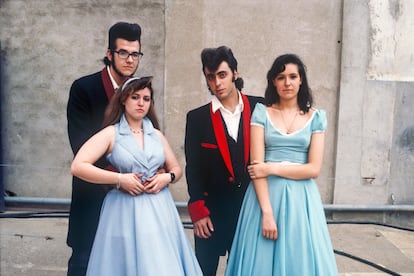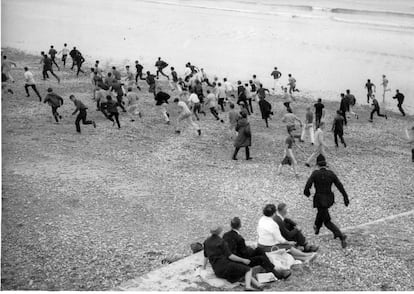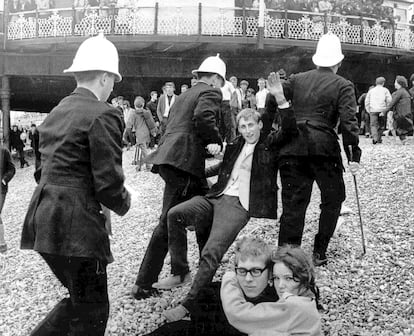Mods and rockers: From fighting in the 1960s to struggling to survive in the 21st century
The two subcultures are suffering from a lack of generational change. A new exhibition recounts their history and idiosyncrasies from the “Battle of Brighton” in 1964, which was featured in the film ‘Quadrophenia,’ to the present day


On May 18, 1964, in the seaside town of Brighton, UK, a bunch of kids got into a fistfight. There were a couple of thousand of them and they belonged to two camps: the mods and the rockers, two of the first subcultures of the second half of the 20th century, fueled by the post-war baby boom that increased the youth population. In reality, there was no express or ideological reason for the clash: bored, riding around on their motorcycles and scooters, in their leather jackets and parkas, mods and rockers roamed the coastal cities during the holidays. One day the spark went off, as it sometimes does at an early age. And all hell broke loose.
There was stone throwing, mass insults, stampedes, and shock in the international press that saw in the event tasty headline fodder to suit all parties. The right (as in Franco’s Spain) painted it as an example of the moral decadence of liberal democracy and the end of tradition. The left labeled it a product of the contradictions of capitalism and a response to the daily alienation of youth. Today, most agree that it was not really that bad.
The history and idiosyncrasies of these two subcultures are recounted in the exhibition Chupas & Parkas (Leather Jackets & Parkas) at the National Museum of Anthropology in Madrid, which opens with the “Battle of Brighton” on the 60th anniversary of those legendary riots. “Back then there were the only two subcultures, kids who dressed differently, with different tastes... It was not unusual for that fight to have taken place, but the truth is that everything was blown out of proportion,” says Rubén Olivares Rosell, rocker advisor to the exhibition, which includes another smaller exhibition: Rockers and mods in Madrid 1980-1990, by Miguel Trillo, a photographer famous for his portraits of urban tribes and youth styles throughout the decades.

The mods were identified by their bangs and sideburns, parkas, thin ties, tailored suits, and loafers, a very elegant styling. The rockers by their leather motorcycle hats and jackets, toupees, hemmed jeans, chains and boots. Although the rockers may have looked like neighborhood punks and the mods like refined sons of the bourgeoisie, both subcultures came from the working class. Mod elegance is especially interesting because it is also claimed by the working class and not just the wealthy elites.
“They were young people who worked all week to go partying on the weekend, to buy records, or go to the tailor. It could be the case that the mail delivery man at the multinational company was more elegant than the boss himself,” says Daniel Llabrés, the exhibition’s mod advisor. Llabrés got his start aged 14, like his rocker co-advisor (both are now 53), when he was in a religious school, in uniform, and realized he had to “play different.” “I saw the mod thing around, in magazines, on TV, in comics, and I understood that had to be my move,” he says.

The exhibition is part of a cycle on urban cultures because anthropology also refers to these phenomena and not just to that which instantly comes to mind: distant ethnicities with distant customs. “It’s a good way to take the museum out of its traditional identity, offer something different, and reach new audiences. It’s also a novel working method that we’ve put into practice, collaborative. It gives a lot of intensity, legitimacy, and social coverage to this type of project,” explains Fernando Sáez, director of the National Museum of Anthropology. The proof of interest was seen by the director at the inauguration, which was attended by 700 people and a fair number of toupees and bangs. And in the three sold-out concerts staged in July. The first exhibition in the cycle was dedicated to hip hop culture through graffiti, and entitled Todo comenzó en el ochenta y cuatro (It all started in 1984). Origins of graffiti in Spain.
Leather Jackets & Parkas also pays tribute to the film Quadrophenia (1979), which contributed to the mod revival of the late 1970s, as did the emergence of the band The Jam and the heat of the punk movement. Curiously, there was also a rocker revival at the same time, also fueled by punk and other subcultures. Not in vain, the Sex Pistols, the epitome of punk, covered rocker music, such as Eddie Cochran, and the music of the mods, such as The Who.
There is no quintessential mod music, but mods incorporate jazz, pop, power pop, soul, northern soul, ska, reggae, rocksteady and a thousand variants that allow all-night dancing, hence the slogan “All Things Mod.” In Spain, the end of Franco’s regime meant the arrival of many of these trends and the mod and the rocker, but also punk, new wave, and goth, scrambled together, sharing spaces, bands, and even coexisting within people who took certain elements of each one to configure their own identity.

That was the era of the Movida madrileña and other subsidiary movements. “I was influenced, on the one hand, by the fact that my mother listened to Elvis, but at that time there were all kinds of subcultures to choose from. Now everything is more homogeneous, and TV is much less musical and varied,” says Olivares Rosell. The movie Grease (1978), although criticized by purists for its stereotyping, also influenced at least one generation to enter the universe of rock n’ roll (Spanish rockers, Olivares notes, were called “travoltas”). The Movida came to an end in 1985 when the rocker Demetrio Lefler was killed in a fight with mods at the doors of the legendary Rock-Ola, which closed after the tragedy. In the aftermath, the rocker and the mod returned to a certain clandestinity, where they remain today.
Keeping the flame alive
One thing that is evident in the exhibition is that, although urban tribes have sometimes been portrayed as hotbeds of juvenile delinquency, ways of breaking bad, the stuff of old lady scare stories, belonging to one of these movements can be enriching for a young person: it brings them closer to cultural expressions such as fashion, music, or literature, provides them with a social circle, and gives them an existential sense. One that some abandon with age, but that others never do. The Spanish mod and rocker scenes, according to Llabrés and Olivares Rossell, are already somewhat diminished. There is little general replacement and the youngest, not large in numbers, are already in their thirties.
“The rock scene, despite everything, is vigorous and established in the big cities and there are also people keeping it going in the villages. We are very diverse people, a reflection of society: there is everything from drivers to lawyers,” says Olivares Rossell. The exhibition cites some mods and rockers clubs, respectively, such as The Boiler, in Barcelona, or Rockersaurios, in Madrid, and festivals like Rockin’Race, in Torremolinos, or the long-lived EuroYeyé in Gijón (now renamed Ye-yé Gijón), which has been going (and dancing) for three decades.
“The mod scene is older in terms of age, but just as young, rebellious and debauched in its state of mind,” says Llabrés. “We don’t care if we die on the dancefloor and all this ends with us.” Incidentally, the subculture has a reputation for being one of the best for turning a year older, given its intrinsic elegance: it’s not the same to reach middle age wearing a Fred Perry polo shirt, horn-rimmed glasses and sideburns, as with a mohawk and studs.
According to Llabrés, in the mod movement in the past, you had to earn your stripes by doing things, publishing a fanzine, organizing parties, DJing, playing gigs, doing radio... Today, people are more easily accepted, because there aren’t many of them. “However, what you see is that many young mods come to the movement, stay for a while, and then move on to something else,” he says. It must be a symptom of liquid postmodernity where everything is ephemeral and fleeting and we live in a continuous vital state of channel surfing. Llabrés and Olivares, mod and rocker, have nothing but good words for each other and have collaborated fraternally on this exhibition, without coming to blows. What happened in Brighton is a long time ago.
Sign up for our weekly newsletter to get more English-language news coverage from EL PAÍS USA Edition
Tu suscripción se está usando en otro dispositivo
¿Quieres añadir otro usuario a tu suscripción?
Si continúas leyendo en este dispositivo, no se podrá leer en el otro.
FlechaTu suscripción se está usando en otro dispositivo y solo puedes acceder a EL PAÍS desde un dispositivo a la vez.
Si quieres compartir tu cuenta, cambia tu suscripción a la modalidad Premium, así podrás añadir otro usuario. Cada uno accederá con su propia cuenta de email, lo que os permitirá personalizar vuestra experiencia en EL PAÍS.
¿Tienes una suscripción de empresa? Accede aquí para contratar más cuentas.
En el caso de no saber quién está usando tu cuenta, te recomendamos cambiar tu contraseña aquí.
Si decides continuar compartiendo tu cuenta, este mensaje se mostrará en tu dispositivo y en el de la otra persona que está usando tu cuenta de forma indefinida, afectando a tu experiencia de lectura. Puedes consultar aquí los términos y condiciones de la suscripción digital.
More information
Archived In
Últimas noticias
Most viewed
- Sinaloa Cartel war is taking its toll on Los Chapitos
- Oona Chaplin: ‘I told James Cameron that I was living in a treehouse and starting a permaculture project with a friend’
- Reinhard Genzel, Nobel laureate in physics: ‘One-minute videos will never give you the truth’
- Why the price of coffee has skyrocketed: from Brazilian plantations to specialty coffee houses
- Silver prices are going crazy: This is what’s fueling the rally










































